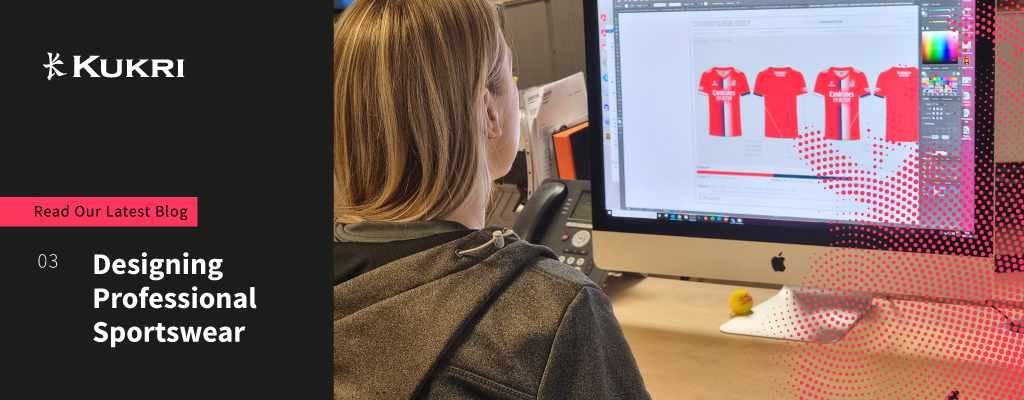Designing professional sportswear
January 7, 2022 | Blog |
For over 20 years Kukri Sports have been providing high quality, bespoke sportswear to a wide variety of professional and grass roots clubs. Over this period, we have obtained a vast amount of experience in what is involved in the design and production processes.
In our latest blog our Designer Hayley Yates sheds light on what goes on behind the scenes at Kukri that allows the business to succeed.
The sports industry is constantly evolving, meaning that it’s essential our products remain innovative, both in design and production. Lighter fabrics are needed when an athlete needs speed, durable fabrics, with reinforced seams for contact sports. As a designer its important to understand these requirements and incorporate them into attractive designs that meet the expectations of our partners, customers, and fans alike.
Skills needed
It goes without saying that creativity is essential when designing sportswear, it’s essential to monitor market trends and incorporate them into unique designs. When designing for teams and clubs they often have stories associated to their history, which should also inspire the designs.
A creative design alone is not enough, in depth knowledge is also needed of how a finished garment is manufactured, from creating a pattern to cutting fabric and sewing. If a designer doesn’t know how to make a garment it’s difficult to understand how a design will look on an athlete and where the panels and prints fit together.
It is also essential to be accurate, with attention to detail, for example professional teams adhere to specific logo regulations, so accuracy is a must when working out logo sizes, otherwise the team may be fined or prevented from wearing the kit.
A designer also needs to have excellent IT skills, design software is important when working with sublimation designs as vector files are needed for manufacturing. Database software knowledge is also needed for critical paths and size charts.
It is also important to have good time management as kits are always needed by specific dates, so deadlines need to be hit and any obstacles must be dealt with quickly to make sure dates aren’t missed.
Ideas
Finding the right inspiration for our designs is fundamental to their success, we research new fabrics, trims, sewing finishes and options for new sublimation and print patterns, whether taken from architecture or street art. Social media is also a good avenue to consider as you can see what people are engaging with and their opinions on certain trends.
Once we reach the ‘ideas’ stage we start to work on a mood board, which is a visual presentation to help give direction and show the process of how designs are to be created. They usually include images for inspiration (photos, sketches, artwork etc.), colours, fabrics and any current trends that the designs relate to. This allows us to understand the foundations for the designs.
Working with partners
Engagement with partners is essential to the creation of successful designs. We are often provided with a brief, with a suggestion for colours and logos. We will ordinarily receive brand guidelines and any historical information or straplines that we could tap into. Regular communication helps strengthen relationships and ensures designs remain aligned with partner expectations.
We often develop our designs/ products alongside our partners so we can ensure that they perform to the high standards expected for each particular sport.
Considerations
Fabric – The relationship between the product and fabric is vital to understand. The kit needs to be fit for purpose and the team need to be in the best fabric for their sport.
Cost – The costs associated to the production of the products is also a key factor as we wouldn’t want to offer a club a product with lots of details that add cost, meaning they can’t afford the final design. Subsequently it is important when retailing the product as you don’t want it to be too expensive for customers.
Location of manufacture – The location of production must be carefully considered, especially when dealing with multiple deadlines. For example UK manufacture is a lot quicker than China, but also more expensive. Critical paths play a big part,as you start with a completion date and work backwards, which in turn can determine where the manufacture will take place.
Previous kit designs – A designer must take previous kit designs into consideration, as it is a balancing act between retaining links to the heritage of the institution and creating new designs each season, to prevent people getting bored or lose interest in the product.
Colours – Usually a team will have set brand guidelines we would need to stick to when designing a home kit. When designing an alternate kit you can usually be more creative and choose colours based around current trends, but you also need to be aware of rival teams to make sure your colours aren’t too similar.
Being a designer at Kukri is fantastic, working on professional kits allows me to be really creative because the teams like to be the leaders in current trends and products its important to constantly be thinking of new ideas.
Being involved in high-profile projects from start to finish is a great experience, starting by going out to do research, then creating designs, receiving samples and eventually seeing the products photographed before uploaded to websites or seeing them in retail stores – before actually seeing the kits in action during competitions. The team at Kukri are very professional and incredibly creative, which helps keep ideas fresh and looking for new ideas.



